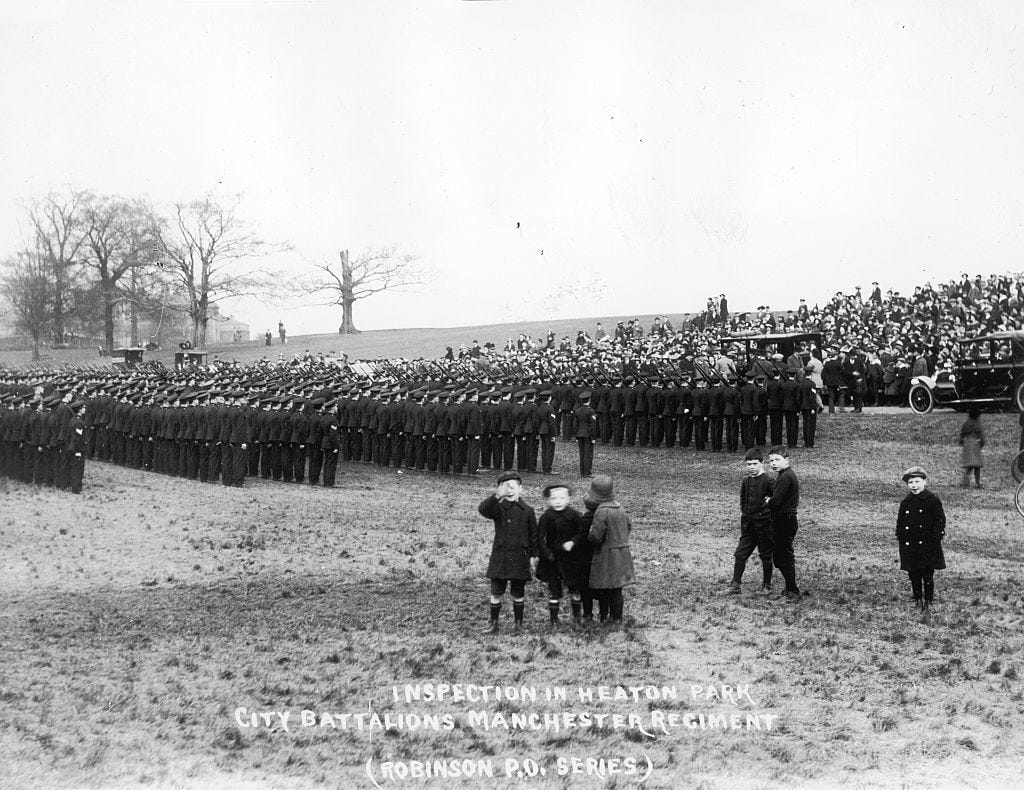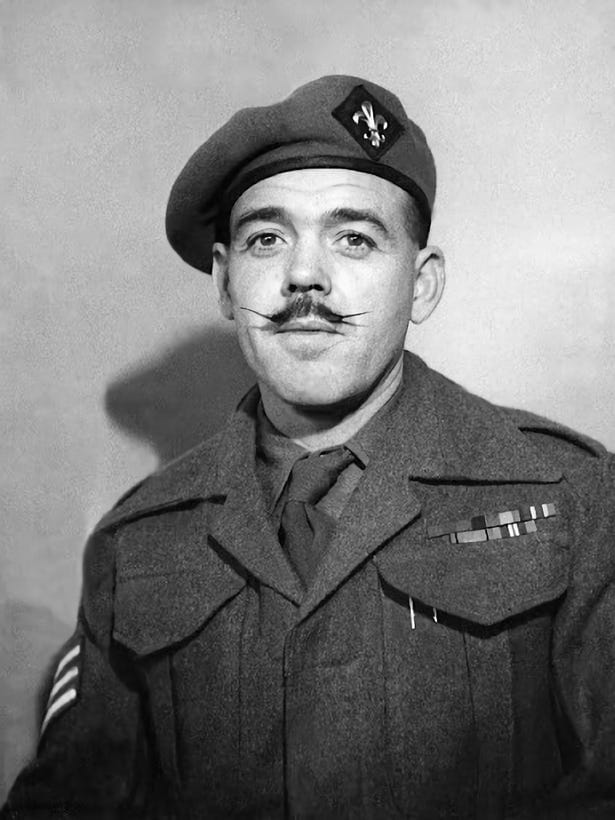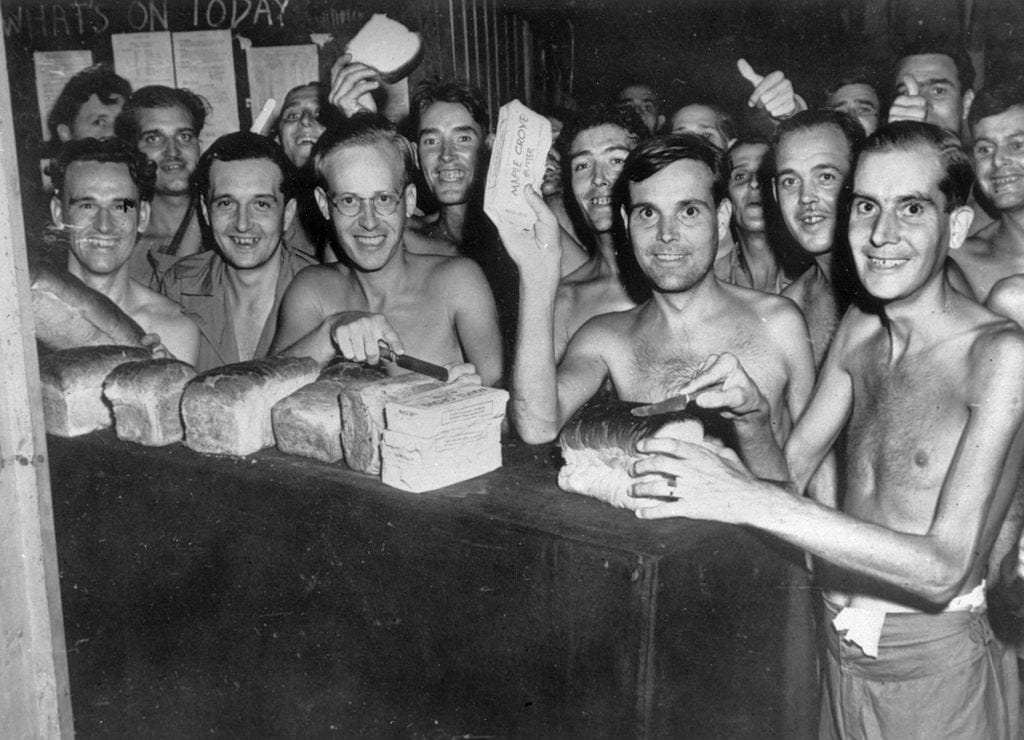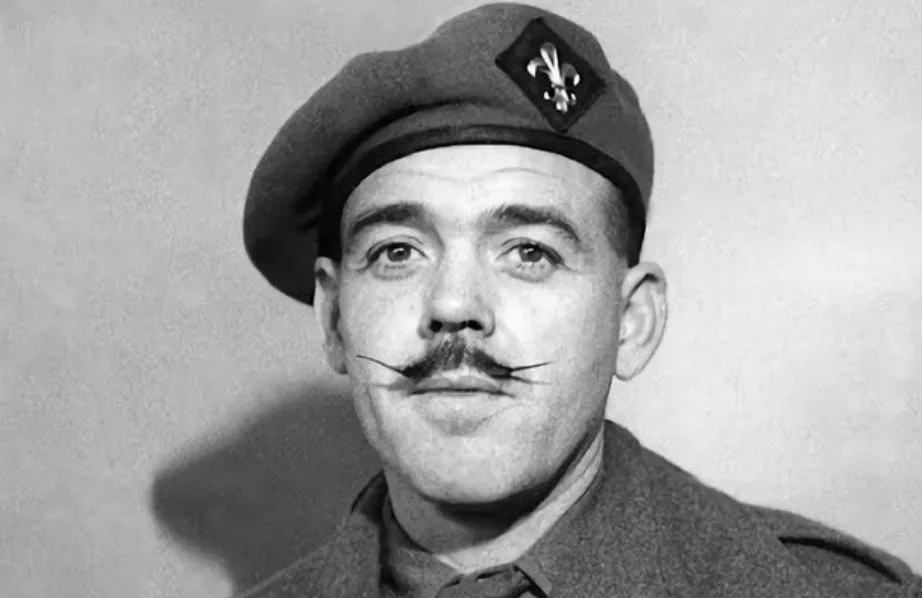Dear Millers — as Remembrance Sunday services and parades take place across the country, we bring you the stories of two local men.
Two Arthurs, in fact. Neither Arthur Powell, who fought in the First World War, nor Arthur Phillips, who found in the Second World War, are famous or have particularly unusual stories. But Dani Cole came across them when she visited the archives this week to learn about what local soldiers had experienced in war, and how they dealt with losing friends on the battlefield.
‘Your Ever Loving Son’
Arthur Powell often made the journey from 76 Hartington Street in Moss Side to his job at Fennel Street, near Manchester Cathedral. He left school in 1910 when he was 14 and was working for the British Engine Insurance Company. His home was a modest three-bed red brick terrace where he, his younger brother Norman and his parents lived.
On 11th July 1914, a few weeks after the assassination of Archduke Franz Ferdinand, the Manchester Guardian reported that St John’s Cathedral in Salford bore witness to a “solemn Reqiuem Mass” for the late Archduke. Members of the diplomatic community were in attendance, including Mr Robert Lederer, Austria-Hungary’s ambassador, and Captain Schlagintweit, ambassador for the German Empire. “The pulpit and other portions of the church were draped with black,” the paper said. War was declared weeks later.
Arthur joined the Manchester Pals in October. The Pals were attached to the Manchester Regiment, a battalion formed of men who volunteered to serve in Lord Kitchener’s New Army. Kitchener, the Secretary of State for War, had recommended that 500,000 volunteers should be recruited for the army to form complete battalions under existing army regiments. Formal conscription hadn’t been introduced yet, but the British Army desperately needed more recruits and the government realised that if men could fight alongside their friends or workmates, more would enlist. Arthur, who was 18, was one of 10,000 men from Manchester to enlist into the Pals.
Four battalions, numbering 4,000 men, marched through Manchester to the Free Trade Hall in January 1915. The spectacle was such that traffic had to be stopped because of the large crowds that lined the streets — swelling in Albert Square, Piccadilly and next to the Royal Exchange. The Manchester Guardian wrote: “There was more stir and excitement in that city than at any time since the war began.” 1,280 men had enlisted in the previous five days.

Arthur’s first two years of the war were divided between army camps in Sussex and Essex and he didn’t see active service until August 1916. His experiences of war are documented at the John Rylands Library in a collection of letters he sent home to his parents. They are touching remnants of a young man who remained positive in the face of unimaginable adversity. He has beautiful handwriting, with elaborate, curling capital letters. In his longer letters, the writing starts lightly and neatly until gradually his hand grows heavy, the words loop large and the pencil marks become darker and darker as he presses down into the paper.
He’s warm and good-natured — in a letter from 20th February 1917, after his brother Norman asked if he’d seen the new £1 notes, he replies: “No I have not they do not throw many of these things about in the army.” According to Arthur’s son Colin, who published a private book of his father’s transcribed letters and donated them to the library in 2014, Arthur never spoke of the war. But in these letters, he offers an unvarnished account to his parents and doesn’t shy away from graphic details. One letter dated April 29th 1917 reads:
For the last few days I have had the gruesome job of burying the dead on the battlefield. The worst job I had was assisting the chaplain to identify the bodies. We were shelled heavily every time we went up & had to withdraw several times. You may tell what it was like when the Chaplain provided himself with a whiskey flask & invited me to partake of its contents which I did most thankfully.
Against all the odds, Arthur survived the bloody fighting of the battles of the Somme, Ypres and Arras. He writes from “Somewhere near Water Pas-de-Calis France” in July 1917:
Since I came out here twelve months ago I have been in the three biggest pushes made. The Somme, Arras & Ypres. I think now that unless Germany submits to our terms that there will be one terrific big push & exit Fritz from Belgium & the N of France. […] The Belgians are a treacherous lot of devils & spies are everywhere.
During his time on the Western Front, as well as suffering from the poor conditions, various infections and trench fever, he was also wounded. At the beginning of the Battle of Passchendaele, he was wounded in the left shoulder and was hospitalised. He returned home to Manchester in May 1919, rejoining the British Engine Insurance Company until his retirement in 1961. He died in 1968, aged 71 from lung cancer and emphysema.
Archivist Penny Blackburn writes on the John Rylands blog that the letters “demonstrate an affectionate, loving bond between son and parents. This was the invisible thread between battlefield and home; love and hope.”

Letter extracts republished courtesy of The John Rylands Library, The University of Manchester.
‘How did you find me?’
In July 1932, 19-year-old Arthur Phillips enlisted into the Manchester Regiment, reporting to Ladysmith Barracks on Mossley Road, Ashton. The barracks had originally been built in 1843 to house the regiment’s cavalry, with men and their chargers clattering about the place. He was a Glossop lad — tall and fresh-faced, the son of mill workers.
His father, Arthur senior, worked in a paper mill; his mother Florence was a cotton weaver, who died when Arthur was 16. The town was huddled on the damp edge of the Peaks, and its climate meant threads were kept supple and workers could weave without fear of them breaking as they spun. When Arthur joined the army, his father was living in one of the sand-coloured houses on High Street. His motivations for joining the army are unclear, but by the 1930s Glossop’s unemployment rate was 57% and its population was dwindling. It’s likely that the army was an attractive prospect for the young man.
His career can be pieced together through letters, family photographs and newspaper clippings housed at Tameside Local Studies and Archives Centre, where the Manchester Regiment archive is one of their largest collections and preserves the legacy of countless soldiers. Arthur is just one of them — his story is bound together in a number of folders that offer a glimpse into his life.
I spent an afternoon in a book-lined room sifting through the materials he’d collected over the years. These folders only offer up a fragment of a life, not the full picture. An archivist explained to me that they could only hold what was donated to them. There was no Hollywood moment of clarity or sudden breakthrough. The collection of his letters is small, and the bulk talk about Arthur. They show a man of keen intellect who excelled in the army — during his service he gained six medals, including a Pacific Star.

He comes across as a cheerful, pleasant man who was well-respected. Arthur left Manchester behind after completing his training at Ashton in 1933 — first going to Jamaica, before being posted to Egypt and Palestine. The British Empire was contracting, and soldiers like Arthur were required to quell local tensions and hang on to control. There is a photo of him in Egypt, posing with a sun helmet in his left hand, his right arm tucked behind his back. The bottom right of the photo is signed in fading ink to his younger sister and her husband: “To Alice & George, all the best.”
“Local studies centres and archives like Tameside offer treasure troves of local and regional resources and materials,” says Dr Frances Houghton, a research fellow at the University of Manchester. She’s also the author of The Veterans' Tale: British Military Memoirs of the Second World War, and some of her research focuses on the experiences of prisoners of war.
In 1940, Arthur was posted to Tanglin Barracks in Singapore. Once a nutmeg plantation, the white buildings of the military base were topped with French-style roof tilings and bordered with palm trees. The Museum of the Manchester Regiment says that the 1st Battalion’s main job was to “build defences and train against invasion”. On 8th December 1941, the Japanese invaded Malaya, and Singapore fell in mid-February. As British forces withdrew, they tried staving off the Imperial Japanese Army by destroying bridges, but all of Japan’s infantry regiments were equipped with engineering units. As the British retreated, equipment and supplies were left behind. British military thinking had deemed the Malayan jungles to be impassable — something that was quickly proved wrong.
Arthur became one of 190,000 British and Commonwealth troops who were taken as Prisoners of War (POWs) after Japan invaded Malaya. Many soldiers were marched into captivity by the Imperial Japanese Army. He was held at Changi Prison on the east side of the island until October 1942, when he was put on a hell ship called Dainichi Maru, bound for Taiwan (then Formosa). The small vessels were often overcrowded, with “seriously sick and malnourished men who were held in appalling conditions,” Dr Houghton says. “POWs were crammed into the ship’s hold and the hatches were battened down for the duration of the voyage.”

He was put to work on Heitor Camp Number 3. The prisoners picked rocks from the dry riverbeds and slung them into woven bamboo baskets to make way for sugarcane plantations. The climate was hot, the work exhausting, and malaria ripped through the men because the swampland to the north of the camp was a perfect breeding ground for mosquitoes. There was no medication for them and beatings were brutal.
When he returned to England in November 1945, after the end of the war, he weighed 38kg, down from 58kg when he enlisted. His malaria was so extreme that “he was treated as something of a guinea pig,” his second wife Lorna recalls in a letter. He had to visit Liverpool for treatment at the Liverpool School of Tropical Medicine. In 1947 he married his first wife Stella at Caxton Hall in London, soon adopting her 8-year-old Clifford (known as Cliff). Stella and Arthur separated in 1955 and lost contact. He married Lorna in 1960.
His time as a Japanese POW undoubtedly left a deep mark on him. In a slim cream folder there are 1990s newspaper cuttings with articles from survivors who were forced to work in “hell camps” like he had, or who built the “Death Railway” (the Siam–Burma Railway). As someone who had suffered in a camp, he must have empathised with their plight and felt a kinship with them.
There are also clippings from other humanitarian crises: One from the Daily Mail dates from 23rd August 1995: “Flight of refugees from terror camps —Rwandans hide out to escape expulsion at gunpoint.” In a smaller column on the opposite side of the page, there is another story: “Pictures raise hopes for British hostages.” Another cutting, this time from the Liverpool Echo in 1993 reads: “Former PoW Wally Fights Cash Battle.” In these clippings lay a community of men who had survived against the odds.
In her research on wartime POWs in the Far East, Dr Houghton notes that one of the things that particularly shocked her was how many men were told not to talk about their experiences when they returned home. They were told it would “upset their families too much”, although it was suspected they were discouraged from sharing their traumas to avoid damaging future trade relations between Britain and Japan. “Very few men ever did speak fully about the suffering they had endured,” she says.
Arthur’s voice is mostly absent in the records but at times there are faint echoes: marginalia on a newspaper cutting for an article entitled “Last salute for the ‘Weary’ hero of the hell camps,” reads in neat blue-inked block capitals: “P. knew him well.” On the 11th November 1997, after 42 years of lost contact, Cliff tracked Arthur down and wrote to him. He replied:
Dear Cliff,
I received your letter as we were about to leave for Manchester Airport for our holiday in Thailand.
It came as quite a shock really but I thank you for all the kind thoughts you have expressed. How did you find me?? We return home on the 27th & I will be in touch after we have settled in.
Yours aye,
Arthur
Arthur died in June 1998 in Wem, Shrewsbury aged 85. “There are so many things he told me,” Lorna writes to Cliff after his death. “I wish I had paid more attention at the time.”

Comments
How to comment:
If you are already a member,
click here to sign in
and leave a comment.
If you aren't a member,
sign up here
to be able to leave a comment.
To add your photo, click here to create a profile on Gravatar.






